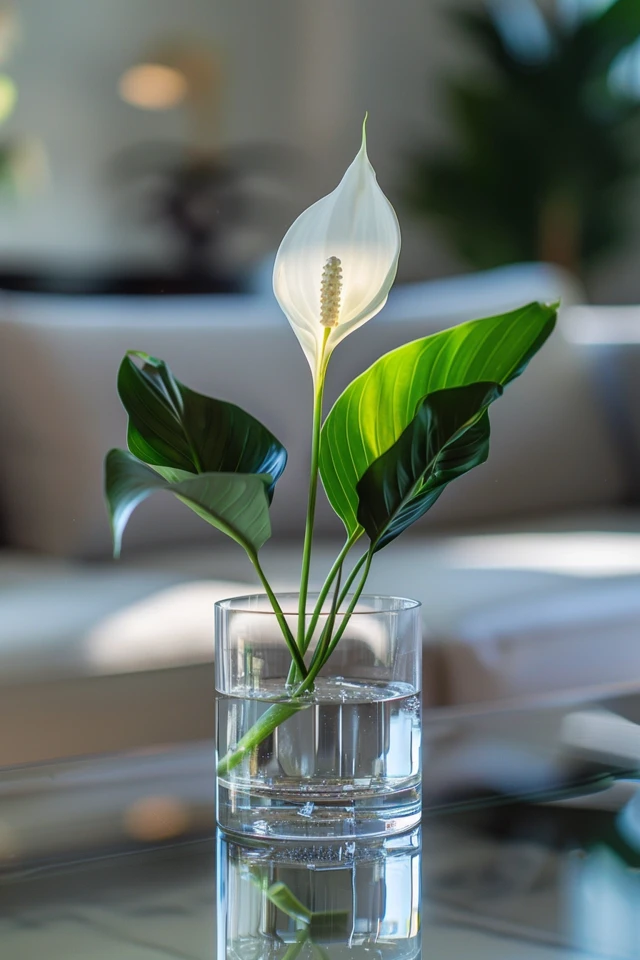Growing a Peace Lily in water is a simple and elegant way to incorporate hydroponics into your indoor gardening routine. With its beautiful white flowers and lush green leaves, the Peace Lily is a popular choice for plant enthusiasts. By following a few easy steps, you can create a stunning display and enjoy the benefits of hydroponic gardening.
Key Takeaways:
- Hydroponic peace lily care involves growing the plant in water instead of soil.
- To grow a peace lily in water, carefully remove the plant from its pot, rinse the roots, and place it in a vase with a saucer.
- Fill the vase with water, making sure to keep the crown of the plant above the waterline to prevent rot.
- Use distilled water or other purified water to ensure the health of the plant.
- Fertilize the peace lily once a month with a hydroponic liquid fertilizer.
- Benefits of growing peace lilies in water include low maintenance, prevention of soil-borne diseases, and indoor air purification.

Steps for Growing a Peace Lily in Water
Here are step-by-step instructions for growing a Peace Lily in water:
- Carefully remove the Peace Lily from its pot and gently work the soil out of the roots. Rinse the roots in running water to remove any additional soil.
- Cut out the center of a clear plastic plant saucer and feed the roots through the opening. Place the plant into a glass vase, ensuring that the saucer sits on the lip of the vase to keep the crown above the waterline.
- Fill the vase with water to the bottom of the saucer and top off as needed to maintain the water level.
- To prevent rot, make sure the crown of the plant is not submerged in the water.
- Optionally, you can add decorative rocks or accents to the bottom of the vase before filling with water.
- Use distilled water, rainwater, or well water to provide the plant with the best-quality water.
- Fertilize the Peace Lily once a month using a liquid fertilizer formulated for hydroponics.
By following these steps, you can grow a thriving Peace Lily in water and enjoy the benefits of hydroponic gardening.

Benefits of Growing Peace Lilies in Water
Growing Peace Lilies in water offers several benefits:
- Low maintenance: Growing Peace Lilies in water eliminates the need for soil and regular repotting. The plant only requires occasional water changes and cleaning of the vase or container.
- Prevention of soil-borne diseases: Hydroponic growth minimizes the risk of root rot and other soil-borne diseases, as the plants’ roots have continuous access to oxygen.
- Beautiful display: Growing a Peace Lily in water creates a unique and visually appealing display. The contrast of the white flowers and green leaves against the clear water is striking.
- Easier monitoring of plant health: With a clear vase, it is easier to spot potential problems with the plant, such as pests or diseases. This allows for timely intervention and maintenance.
- Indoor air purification: Peace Lilies are known for their ability to purify indoor air by removing toxins. This benefit is not hindered when growing them in water.
- Root growth observation: Growing a Peace Lily in water allows you to observe and appreciate the development and health of the plant’s root system, adding an educational aspect to your gardening experience.
By growing Peace Lilies in water, you can enjoy these benefits while embracing hydroponic gardening. It’s a low-maintenance, visually stunning, and healthy way to incorporate these beautiful plants into your indoor space.

Conclusion
Growing a Peace Lily in water through hydroponics is a rewarding and aesthetically pleasing way to enjoy this elegant plant. By following the step-by-step guide and considering the benefits, you can successfully cultivate a thriving Peace Lily in water.
Remember to use distilled water or other purified water, fertilize the plant monthly, and monitor its health and water levels. With proper care, your Peace Lily will bring a sense of tranquility and natural beauty to your indoor space.

